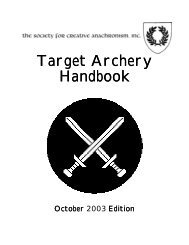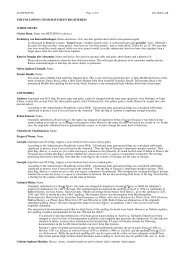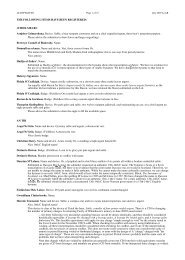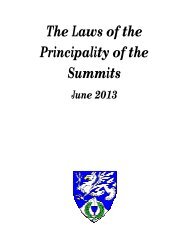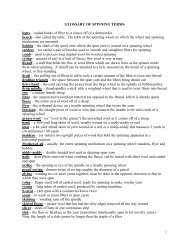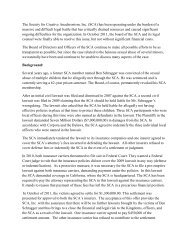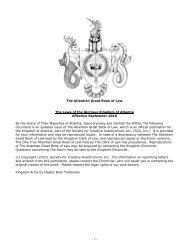The Standards for Evaluation of Names and Armory - SCA Heraldry
The Standards for Evaluation of Names and Armory - SCA Heraldry
The Standards for Evaluation of Names and Armory - SCA Heraldry
You also want an ePaper? Increase the reach of your titles
YUMPU automatically turns print PDFs into web optimized ePapers that Google loves.
NPN. Non-Personal <strong>Names</strong><strong>The</strong> <strong>St<strong>and</strong>ards</strong> <strong>for</strong> <strong>Evaluation</strong> <strong>of</strong> <strong>Names</strong> <strong>and</strong> <strong>Armory</strong>:<strong>The</strong> Rules <strong>for</strong> SubmissionsNon-personal names are names other than personal names. <strong>The</strong>y include branch (local group) names, award <strong>and</strong>order names, household <strong>and</strong> association names (including guilds), <strong>and</strong> heraldic titles. To be registered, a nonpersonalname submission must meet the following st<strong>and</strong>ards:- <strong>The</strong> designator <strong>and</strong> substantive element must be demonstrated to be suitable <strong>for</strong> the type <strong>of</strong> item.Each type <strong>of</strong> element must be suitable <strong>for</strong> a specific time <strong>and</strong> place or must otherwise meet thest<strong>and</strong>ards set out in NPN.1.- <strong>The</strong> name as a whole must be demonstrated to be grammatically (structurally) correct. This meansmeeting the st<strong>and</strong>ards <strong>for</strong> lingual <strong>and</strong> temporal compatibility set out in NPN.2.- <strong>The</strong> name must be free <strong>of</strong> conflict <strong>and</strong> presumption as set out in NPN.3 <strong>and</strong> NPN.4.- <strong>The</strong> name must not be <strong>of</strong>fensive as set out in NPN.5.NPN.1. Non-Personal <strong>Names</strong> ContentA. Definitions: Non-personal names consist <strong>of</strong> two parts: the designator <strong>and</strong> the substantive phrase. A designatoris the word or group <strong>of</strong> words that describe what kind <strong>of</strong> non-personal name it is, such as House, Barony orOrder. <strong>The</strong> substantive element is the part <strong>of</strong> the name that is specific to the item being submitted. That is, itspecifies which household, branch, etc. is being referred to. <strong>The</strong> preposition <strong>and</strong> article which <strong>of</strong>ten link thedesignator <strong>and</strong> substantive element are <strong>for</strong> the most part treated as part <strong>of</strong> neither, but in general should matchthe designator in language.For example, in the name Barony <strong>of</strong> Carolingia, Barony is the designator <strong>and</strong> Carolingia the substantiveelement. In the name Black Lion Principal Herald, Principal Herald is the designator <strong>and</strong> Black Lion thesubstantive element. In the name the honurable Ordre <strong>of</strong> the Gartier, the honurable Ordre is the designator<strong>and</strong> Gartier the substantive element. In the name Hous <strong>of</strong> Julyane Huxster, Hous is the designator <strong>and</strong>Julyane Huxster is the substantive element. In each case, the preposition <strong>and</strong> article that may link them arepart <strong>of</strong> neither one.B. Designators: <strong>The</strong> designators which may be used are determined by the type <strong>of</strong> non-personal namesubmission. In general, if the lingua Anglica <strong>for</strong>m <strong>of</strong> a designator is used, the prepositions <strong>and</strong> articles whichjoin the designator to the substantive element will also take the lingua Anglica <strong>for</strong>m. Lingua Anglica allowsEnglish translations <strong>of</strong> certain elements; it is discussed in greater detail in C.2.c below.1. Branch Designators: <strong>The</strong> designators <strong>for</strong> branches (local <strong>SCA</strong> groups) are fixed by the GoverningDocuments. <strong>The</strong> list may be found in Appendix E <strong>of</strong> this document. <strong>The</strong>se designators are considered to becompatible with any place name construction. This is true whether or not period <strong>for</strong>ms can be found withsuch a designator. Shires are not limited to the <strong>for</strong>ms <strong>of</strong> English shires, nor baronies to the kinds <strong>of</strong> namesfound <strong>for</strong> baronies in period. In addition, each type <strong>of</strong> branch may be registered with other designatorssuitable <strong>for</strong> that branch type. A college may be named following the pattern <strong>of</strong> medieval colleges. <strong>The</strong>sedesignators may take the lingua Anglica <strong>for</strong>m, using the <strong>for</strong>m Designator <strong>of</strong> X regardless <strong>of</strong> the language <strong>of</strong>the substantive phrase. Alternately, a translation <strong>for</strong> the appropriate type <strong>of</strong> branch may be proposed. A list<strong>of</strong> translations that have been registered can be found in Appendix E.In general, changes <strong>of</strong> status <strong>for</strong> a branch, such as changing from shire to barony, do not need to besubmitted. <strong>The</strong> Laurel <strong>of</strong>fice does not track those changes in status (that being a duty <strong>of</strong> the Seneschal <strong>and</strong>Board <strong>of</strong> Directors). However, it will acknowledge them when a new submission is made. <strong>The</strong> exception iswhen a branch wants the approval <strong>of</strong> a new alternate <strong>for</strong>m <strong>of</strong> the branch designator, such as a non-English<strong>for</strong>m. Such approval requires Laurel approval, but is an administrative action (which does not require fees)<strong>St<strong>and</strong>ards</strong> <strong>for</strong> <strong>Evaluation</strong> <strong>of</strong> <strong>Names</strong> <strong>and</strong> <strong>Armory</strong> – April 29, 2012 - Page 22 <strong>of</strong> 73



